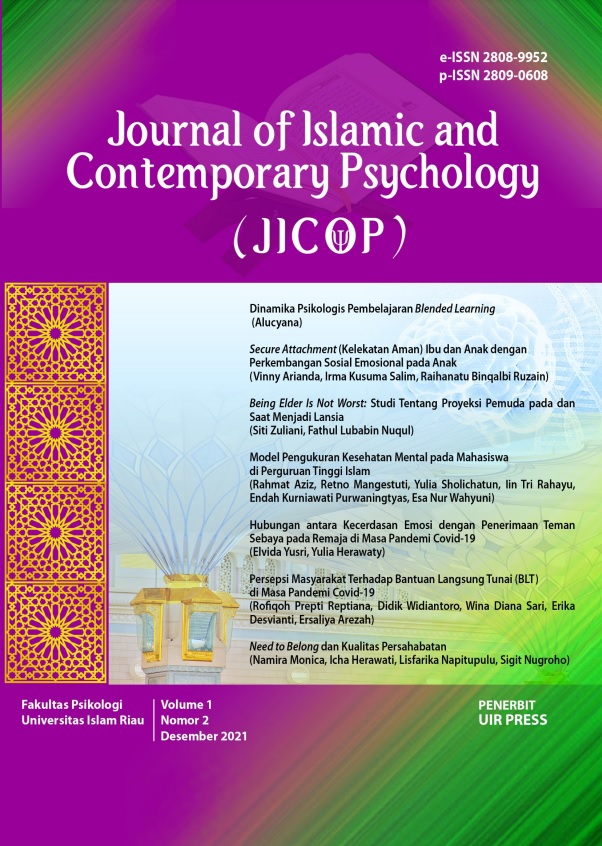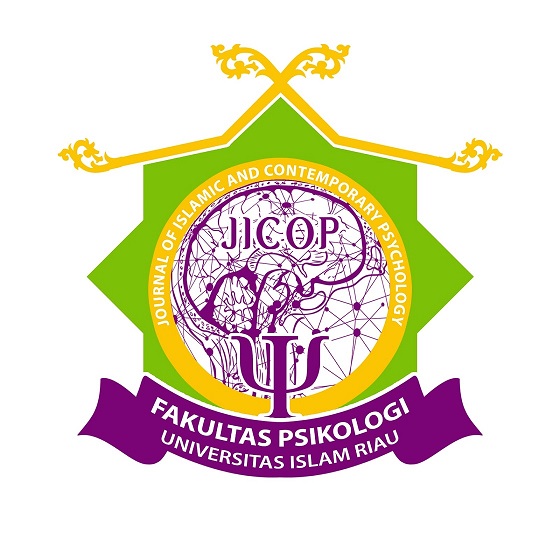Dinamika Psikologis Pembelajaran Blended Learning
DOI:
https://doi.org/10.25299/jicop.v1i2.8490Keywords:
Psychological Dynamics, Learning, Blended LearningAbstract
The Covid-19 pandemic has changed many lines of life, both economic, social and educational. The economic sector suffered massive losses. Several transportation companies were forced to ground their fleets due to this pandemic. In the social sector, there are also social restrictions. The government appeals to the public to limit activities outside the home with the aim of breaking the chain of the spread of Covid 19. Another sector that has also been affected by the Covid-19 Pandemic is the world of Education. Distance learning with an online system must be done so that learning continues. One of the learning models used in distance learning is Blended Learning. This learning is considered effective to adjust in this Pandemic period. Even though it is indicated, even though this Pandemic disaster is over, the Blended Learning learning model can still be used, given the increasingly rapid development of technology. It's just that the implementation of the blended learning learning model also leaves problems to be solved. Psychological dynamics occur for teachers, parents and students. The teacher becomes worried whether the learning that the teacher conveys has reached the target for the students. Parents also become anxious, because they are limited in using technology and have to accompany their children while studying. Students also become bored because they have to use electronic media such as cellphones, computers and others every day. This article aims to describe theoretically about Psychological Dynamics in Blended Learning.
Downloads
References
Ellis, W. E., Dumas, T. M., & Forbes, L. M. (2020). Physically isolated but socially connected: Psychological adjustment and stress among adolescents during the initial COVID-19 crisis. Canadian Journal of Behavioural Science/Revue canadienne des sciences du comportement, 52(3), 177-187. DOI: https://doi.org/10.1037/ cbs0000215 DOI: https://doi.org/10.1037/cbs0000215
Kartiningrum, E. D. (2015). Panduan Penyusunan Studi Literatur. Mojokerto: LPPM Poltekes Majapahit.
Kemdikbud, & Kemdikbud, pengelola web. (2020). Pedoman Penyelenggaraan Belajar dari Rumah. In Jakarta, 28 Mei 2020.
Livana, M., & Basthomi, Y. (2020). Penyebab Stres Mahasiswa Selama Pandemi Covid-19. Jurnsl Ilmu Keperawatan Jiwa, 3(2), 203-208.
Prayitno, W. (2015). Implementasi Blended Learning dalam Pembelajaran pada Pendidikan Sekolah Dasar dan Menengah. Jurnal Pendidikan, 6(01).
Republika Online, (2020, 29 Maret). Covid-19 Terus Meningkat, KAI Batalkan 28 KA Jarak Jauh. [Online] Tersedia: (29 Maret 2020/)
Semler, S. (2005). Use blended learning to increase learner engagement and reduce training cost. (On-line) dalam http://www. learningsim. com/content/lsnews/blended_learning1. html. Diunduh, 11.
Setiawan, N. H. A., & Abdulkarim, A. (2019). Application of Board Game Pancasila Dadu (Pandu) in Civic Learning. In Annual Civic Education Conference (Vol. 418, pp. 467-470).
Susanti, D. I., & Prameswari, J. Y. (2020). Adaptasi Blended Learning di Masa Pandemi COVID-19 untuk Pembelajaran Bahasa Inggris di Sekolah Dasar. Lingua Susastra, 1(2), 50-61. DOI: https://doi.org/10.24036/ls.v1i2.8
UNESCO. (2020). Covid-19 Education: From disruption to recovery. Unesco.
Widyaningsih, S. W., Yusuf, I., Prasetyo, Z. K., & Istiyono, E. (2020). Online interactive multimedia oriented to HOTS through e-learning on physics material about electrical circuit. JPI (Jurnal Pendidikan Indonesia), 9(1), 1-14. DOI: https://doi.org/10.23887/jpi-undiksha.v9i1.17667
World Health Organization. (2021). WHO Coronavirus Disease 2019 (COVID19) Dashboard. WHO.Int.
Downloads
Published
How to Cite
Issue
Section
License
This work is licensed under a Creative Commons Attribution - ShareAlike 4.0 International License (CC BY-SA)
This is an open-access article distributed under the terms of the Creative Commons Attribution-ShareAlike 4.0 International License which permits unrestricted use, distribution, and reproduction in any medium. Copyrights of all materials published in Journal of Islamic and Contemporary Psychology (JICOP) are freely available without charge to users or / institution. Users are allowed to read, download, copy, distribute, search, or link to full-text articles in this journal without asking by giving appropriate credit, provide a link to the license, and indicate if changes were made. All of the remix, transform, or build upon the material must distribute the contributions under the same license as the original.








